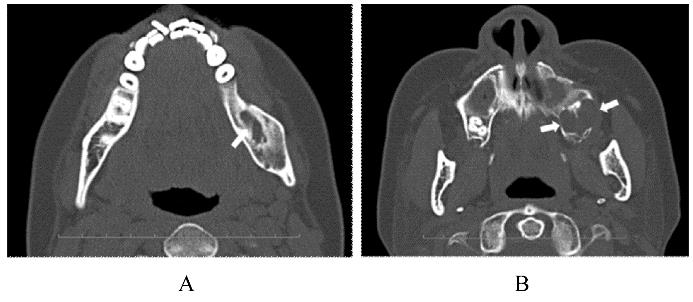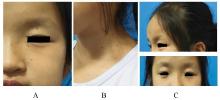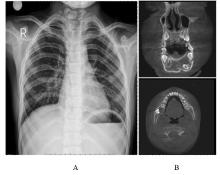| 1 |
BORGHESI A, NARDI C, GIANNITTO C, et al. Odontogenic keratocyst: imaging features of a benign lesion with an aggressive behaviour[J]. Insights Imaging, 2018, 9(5): 883-897.
|
| 2 |
CHIRAPATHOMSAKUL D, SASTRAVAHA P, JANSISYANONT P. A review of odontogenic keratocysts and the behavior of recurrences[J]. Oral Surg Oral Med Oral Pathol Oral Radiol Endod, 2006, 101(1): 5-9;discussion10.
|
| 3 |
SHIMADA Y, MARUOKA Y, YAMAJI I, et al. Non-syndromic familial keratocystic odontogenic tumour: a rare case report in Japanese identical twins[J]. J Clin Diagn Res, 2016, 10(8): ZD28-ZD30.
|
| 4 |
HEGDE S, SHETTY S R. Radiological features of familial Gorlin-Goltz syndrome[J]. Imaging Sci Dent, 2012, 42(1): 55-60.
|
| 5 |
MOHANTY S, DABAS J, VERMA A, et al. Surgical management of the odontogenic keratocyst: a 20-year experience[J]. Int J Oral Maxillofac Surg, 2021,50(9): 1168-1176.
|
| 6 |
NATH P, MENON S, SHAM M E, et al. Conservative management of odontogenic keratocyst in a tertiary hospital[J]. Ann Maxillofac Surg, 2020, 10(1): 122-126.
|
| 7 |
SUN L S, LI X F, LI T J. PTCH1 and SMO gene alterations in keratocystic odontogenic tumors[J]. J Dent Res, 2008, 87(6): 575-579.
|
| 8 |
ANCHLIA S, VYAS S, BAHL S, et al. Gorlin-Goltz syndrome in twin brothers: an unusual occurrence with review of the literature[J]. BMJ Case Rep, 2015, 2015: bcr2015211608.
|
| 9 |
DIXIT S, ACHARYA S, DIXIT P B. Multiple odontogenic keratocysts associated with Gorlin-Goltz syndrome[J]. Kathmandu Univ Med J (KUMJ), 2009, 7(28): 414-418.
|
| 10 |
任 俊, 郭丽娟, 杨 森. 痣样基底细胞癌综合征1例报道[J]. 口腔医学, 2019, 39(12): 1127-1130.
|
| 11 |
CASAROTO A R, LOURES D C, MORESCHI E,et al.Early diagnosis of Gorlin-Goltz syndrome: case report[J]. Head Face Med, 2011, 7: 2.
|
| 12 |
WANG X X, ZHANG J, WEI F C. Familial multiple odontogenic keratocysts[J]. J Dent Child (Chic), 2007, 74(2): 140-142.
|
| 13 |
王彦瑾, 谢晓艳, 洪瑛瑛, 等. 844例牙源性角化囊肿的临床病理学分析[J]. 北京大学学报(医学版), 2020, 52(1): 35-42.
|
| 14 |
KARHADE D S, AFSHAR S, PADWA B L. What is the prevalence of undiagnosed nevoid basal cell carcinoma syndrome in children with an odontogenic keratocyst? [J]. J Oral Maxillofac Surg, 2019, 77(7): 1389-1391.
|
| 15 |
金志勤, 孙 健, 邵 丹. 牙源性角化囊肿的基础与临床之我见[J]. 现代口腔医学杂志, 2012, 26(4): 217-221.
|
| 16 |
FIDELE N B, YUEYU Z, ZHAO Y, et al. Recurrence of odontogenic keratocysts and possible prognostic factors: review of 455 patients[J]. Med Oral Patol Oral Cir Bucal, 2019, 24(4): e491-e501.
|
| 17 |
STOELINGA P J W, SLUSARENKO DA SILVA Y. The significance of recurrent odontogenic keratocysts in bone grafts[J]. Int J Oral Maxillofac Surg, 2021,50(6): 746-749.
|
| 18 |
KALIA V, KAUSHAL N, KALRA G. The syndromic multiple odontogenic keratocyst in siblings: a familial study[J]. Ann Maxillofac Surg, 2011, 1(1): 77-82.
|
| 19 |
TARAKJI B, BAROUDI K, HANOUNEH S, et al. Possible recurrence of keratocyst in nevoid basal cell carcinoma syndrome: a review of literature[J]. Eur J Dent, 2013, 7(): S126-S134.
|
| 20 |
FIDELE N B, ZHAO Y F, TIANFU W, et al. Treatment of multiple odontogenic keratocysts involving Chinese patients[J].J Oral Maxillofac Surg,2019,77(10): 2044-2054.
|
| 21 |
KACZMARZYK T, MOJSA I, STYPULKOWSKA J. A systematic review of the recurrence rate for keratocystic odontogenic tumour in relation to treatment modalities[J]. Int J Oral Maxillofac Surg, 2012, 41(6): 756-767.
|
 )
)











